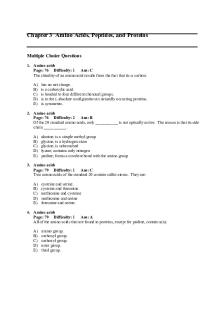CH03 - testbank PDF

| Title | CH03 - testbank |
|---|---|
| Course | Conflict and negotiation |
| Institution | University of Guelph |
| Pages | 15 |
| File Size | 261.2 KB |
| File Type | |
| Total Downloads | 43 |
| Total Views | 162 |
Summary
testbank...
Description
TRUE/FALSE. Write 'T' if the statement is true and 'F' if the statement is false 1) Although
the conflict may appear initially to be win-lose to the parties, discussion and mutual exploration will usually suggest win-win alternatives. Answer:
True
False
2) Those wishing
to achieve integrative results find that they must manage the context and process of the negotiation in order to gain the willing co-operation and commitment of the other party. Answer:
True
3) Effective information Answer:
True
False
exchange stunts the development of good integrative solutions. False
4) Successful integrative negotiation
requires that the negotiators search for solutions that meet the
needs and objectives of all sides. Answer:
True
False
5) Research
shows that the failure to reach integrative agreements is often linked to the excessive exchange of information. Answer:
True
False
6) In
an integrative negotiation, negotiators must be flexible about their interests and needs, but firm about the manner in which these interests and needs are met through solutions. Answer:
True
False
7) In
integrative negotiation, outcomes are measured by the degree to which they meet both negotiators' goals. Answer:
8) In
True
False
integrative negotiation, the goals of the parties are mutually exclusive.
Answer:
True
False
9) Integrative agreements
have been shown to be facilitated when parties exchanged information about their positions on particular issues, but not necessarily about their priorities on those issues. Answer:
True
10) Negotiators Answer:
False
should be firm and inflexible.
True
False
MULTIPLE CHOICE. Choose the one alternative that best completes the statement or answers the question
of the following is not an element of integrative negotiations? A) A focus on commonalities B) The use of objective criteria for standards of performance C) A required exchange of information and ideas D) An attempt to address positions
11) Which
Answer: D
1
12) Which
of the following processes is central to achieving almost all integrative agreements? A) Exchanging information about each party's position on key issues B) Searching for solutions that maximize the substantive outcome for both parties C) Moderating the free flow of information to ensure that each party's position is accurately stated D) Emphasizing the commonalties between the parties
Answer: D TRUE/FALSE. Write 'T' if the statement is true and 'F' if the statement is false 13) For
a situation to be integrative, the negotiation must include more than one issue.
Answer:
True
False
14) If
the negotiation is likely to recur over time this is a sign that the situation calls for an integrative approach. Answer:
True
False
15) If
negotiators approach the problem and their "opponent" in win—lose terms–integrative negotiation cannot occur. Answer:
True
False
MULTIPLE CHOICE. Choose the one alternative that best completes the statement or answers the question 16) Which
of the following factors, or clues, usually indicate that an integrative approach is called for? A) The negotiation is unlikely to ever occur again. B) It is not possible to add more issues to the mix. C) The parties have varying preferences across the issues. D) The negotiation includes a single issue.
Answer: C TRUE/FALSE. Write 'T' if the statement is true and 'F' if the statement is false 17) The Pareto
Efficient Frontier contains a point where there is no agreement that would make any party better off without making the second party worse off. Answer:
True
18) Value that is Answer:
False
created should not be claimed.
True
False
19) Every time you
find yourself in an integrative situation, one of your goals should be to create a deal th the Pareto efficient frontier. Answer:
True
20) The tension
False
between value creating and value claiming is sometimes called the negotiator's
dilemma. Answer:
True
False
2
21) Interests
are the underlying concerns, needs, or fears that motivate a negotiator to take a particular
position. Answer: 22) Process
True
False
interests are related to the way a dispute is started.
Answer:
True
23) Logrolling Answer:
False
is the process of exchanging low-priority issues for issues of higher priority. True
False
24) Nonspecific compensation
occurs in integrative negotiation when one party is allowed to obtain his/her objectives and then "pays off" the other person for accommodating his/her interests. Answer:
True
False
25) Successful bridging requires
a fundamental reformulation of the problem such that the parties are no longer squabbling over their positions; instead, they are disclosing sufficient information to discover their interests and needs and then inventing options that will satisfy both parties' needs. Answer:
True
False
26) The strategy of
logrolling is effective not only in inventing options but also as a mechanism to separate options into different negotiated packages. Answer:
True
27) The Pareto Answer: 28) Interests
False
efficient frontier is simply creating maximum value then claiming maximum value. True
False
are the underlying concerns and needs that frustrate a negotiator into a particular position.
Answer:
True
False
29) If
both parties understand the motivating factors for the other, they may recognize possible compatibilities in interests that permit them to invent options which both will endorse as an acceptable settlement. Answer:
True
False
30) Intrinsic relationship
interests exist when the parties derive positive benefits from the relationship and do not wish to endanger future benefits by souring it. Answer:
True
False
31) Focusing
on interests can be harmful to a group of negotiators whose consensus on a particular issue is built around a unified position rather than a more generalized set of interests. Answer:
True
False
32) "Expanding
the pie" as a method of generating alternative solutions is a complex process, as it requires much more detailed information about the other party than do other methods. Answer:
True
False
3
33) In
logrolling, if the parties do in fact have different preferences on different issues, each party gets their most preferred outcome on their high-priority issue and should be happy with the overall agreement. Answer:
True
False
34) Successful bridging requires
a fundamental reformulation of the problem such that the parties are no longer squabbling over their positions; instead, they are disclosing sufficient information to discover their interests and needs and then inventing options that will satisfy both parties' needs. Answer:
True
False
35) In
generating alternative solutions to the problem, groups should also adopt procedures for defining the problem, defining the interests, and generating options, however, to prevent the group process from degenerating into a win-lose competition or a debating event. Answer:
True
False
36) Solutions
that are not strongly advocated by at least one negotiator should remain in contention, as they may be feasible later on. Answer:
True
False
MULTIPLE CHOICE. Choose the one alternative that best completes the statement or answers the question 37) All of
the following are considered important steps in the integrative negotiation process, except: to the problem B) Understanding the problem and bringing interests and needs to the surface C) Identifying and defining the problem D) refusing to negotiate as a group A) Generating alternative solutions
Answer: D 38) The tension
between value creating and value claiming is sometimes called: B) the prisoner's dilemma dilemma C) the conspirator's dilemma D) the negotiator's dilemma A) Parteo's
Answer: D 39) An
interest is considered instrumental and intrinsic if: A) the parties value it because it helps them derive other outcomes in the future. B) the parties value the interest in and of itself. C) the relationship is valued for both its existence and for the pleasure that sustaining the relationship creates. D) it relates to "tangible issues" or the focal issues under negotiation.
Answer: D 40) ________
relationship interests exist when the parties value the relationship both for its existence and for the pleasure or fulfillment that sustaining it creates. A) Intrinsic B) Instrumental C) Process D) Substantive Answer: A
4
41) ________
relationship interests exist when the parties derive substantive benefits from the relationship and do not want to endanger future benefits by souring it. A) Instrumental B) Substantive C) Intrinsic D) Process Answer: A
42) Substantive interests: A) are related
to the way we settle the dispute. B) are the interests that relate to the focal issues under negotiation. C) regard what is fair, what is right, what is acceptable, what is ethical, or what has been done in the past, and should be done in the future. D) mean that one or both parties value their relationship with each other and do not want to take actions that will damage the relationship. Answer: B 43) Successful logrolling
requires:
A) a fundamental reformulation
of the problem such that the parties are disclosing sufficient information to discover their interests and needs and then inventing options that will satisfy both parties' needs. B) that one party is allowed to obtain his/her objectives and he/she then "pays off" the other party for accommodating his/her interests. C) that the parties establish more than one issue in conflict and then agree to trade off among these issues so one party achieves a highly preferred outcome on the first issue and the other person achieves a highly preferred outcome on the second issue. D) no additional information about the other party than his/her interests, and assumes that simply enlarging the resources will solve the problem. Answer: C 44) What approach
can parties use to generate alternative solutions by redefining the problem or
problem set? A) Logrolling C) Brainstorming
B) Nonspecific compensation D)
A bridge solution
Answer: D 45) In
nonspecific compensation: are added in such a way that both sides can achieve their objectives. B) the parties are able to invent new options that meet each side's needs. C) one party achieves his/her objectives and the other's costs are minimized if he/she agrees to go along. D) one person is allowed to obtain his/her objectives and "pay off" the other person for accommodating his interests. A) resources
Answer: D
5
46) Which
of the following questions can be asked to facilitate nonspecific compensation? A) What risks and costs does my proposal create for the other? B) How can both parties get what they are demanding? C) What are the other party's goals and values? D) What issues are of higher and lower priority to me?
Answer: C 47) "What are the other's
real underlying interests and needs?" is a question that can facilitate what kind of process? A) Logrolling B) Bridging C) Nonspecific compensation D) Expanding the pie Answer: B
TRUE/FALSE. Write 'T' if the statement is true and 'F' if the statement is false 48) Integrative negotiation
solutions should be judged on two major criteria: how good they are and how acceptable they will be to those who have to implement them. Answer:
True
False
49) Sam and
Sally are negotiating the terms of an employment contract. Sam asks Sally why medical benefits are so important to her. Sally gets defensive when asked this question. At this point, Sam should explain to Sally that his intent is to search for possible underlying interests that might facilitate a collaborative settlement rather than to challenge a perspective. Answer:
True
False
50) Groups
of twenty to thirty people, composed of representatives from each faction, side, or subgroup, will be able to work more effectively than a group of six to eight people. Answer:
True
False
51) When
a specific solution must meet the criteria of both quality and acceptability, those evaluating the solution options may have to be prepared to make trade-offs between the two to insure that both criteria are met. Answer:
True
False
52) Intangibles
can lead the negotiator to fight harder to attain a particular solution option if that option satisfies both tangibles and intangibles. Answer:
True
False
6
MULTIPLE CHOICE. Choose the one alternative that best completes the statement or answers the question 53) When
confronted with complex problems, or a large number of alternative options, which of the following steps is necessary? A) Broaden the range of solution options B) Maintain a focus on the influence of tangibles in selecting options C) Decide on criteria while evaluating options D) Evaluate solutions on the basis of quality and acceptability Answer: D
54) Which
guideline should be used in evaluating options and reaching a consensus? A) be alert to the influence of intangibles in selecting options B) keep the range of solution options as wide as possible C) evaluate the solutions on the basis of speed and expediency D) keep detailed records throughout the discussion and evaluation process
Answer: A TRUE/FALSE. Write 'T' if the statement is true and 'F' if the statement is false 55) A
shared goal is one in which the parties work toward a common end but benefit differently.
Answer: 56) A
True
False
common goal is one that both parties work toward but that benefits each party differently.
Answer:
True
False
57) For
integrative negotiation to succeed, the parties must be motivated to compete rather than to collaborate. Answer:
True
False
58) Even
co-operatively motivated negotiators had less trust, exchanged less information about preferences and priorities, and achieved agreements of lower joint profit when they could punish the other party than when they did not have this capability. Answer:
True
59) People who Answer:
False
are interdependent but do not trust each other will act tentatively or defensively.
True
False
60) When
people trust each other, they are more likely to share information and to communicate accurately their needs, positions, and the facts of the situation. Answer:
True
False
61) When
there are strong positive feelings or when one or more parties are inclined to cooperate, negotiators may create formal, structured procedures for communication. Answer:
True
False
7
62) A
common goal is one in which all parties share the result equally.
Answer:
True
False
63) Negotiators
who are firmer about insisting that their own point of view become incorporated into the group solution achieve less integrative agreements than those who are less firm. Answer:
True
False
64) For
successful integrative negotiation to occur, each party should be as interested in the objectives and problems of the other side as each is in his own. Answer:
True
False
65) Although
there is no guarantee that trust will lead to collaboration, there is plenty of evidence to suggest that mistrust inhibits collaboration. Answer:
True
False
66) Multiple communication
channels should not be used as they inevitably pass along inaccurate and
confusing information. Answer:
True
False
MULTIPLE CHOICE. Choose the one alternative that best completes the statement or answers the question 67) A
common goal is one in which: share the result equally B) individuals with different personal goals agree to combine them in a collective effort. C) the parties work toward a common end but benefit differently D) all parties work together to achieve some output that will be shared A) all parties
Answer: C 68) A
joint goal is one in which: with different personal goals agree to combine them in a collective effort. B) all parties work together to achieve some output that will be shared. C) the parties work toward a common end but benefit differently. D) all parties share the result equally. A) individuals
Answer: A
8
69) Which
of the following is not necessary for integrative negotiation to succeed? A) Needs have to be made explicit, similarities have to be identified, and differences have to be recognized and accepted. B) Each party should be as interested in the objectives and problems of the other as each is in his/her own - each must assume responsibility for the other's needs and outcomes as well as for his/her own. C) The parties must be willing to adopt interpersonal styles that are more congenial than combative, more open and trusting than evasive and defensive, more flexible (but firm) than stubborn (but yielding). D) The parties must be committed to a goal that benefits both of them rather than to pursuing only their own ends.
Answer: B 70) All of
the following factors contribute to the development of trust between negotiators, except: trust someone we perceive as similar to us or as holding a positive attitude toward us. B) We are more likely to trust people who initiate co-operative, trusting behaviour. C) We often mistrust people who are dependent upon us because we are in a position to help or hurt them. D) We are more likely to trust negotiators who make concessions. A) We are more likely to
Answer: C 71) When
people do not trust each other, they are more than likely to engage in which of the following behaviours? A) communicating accurately B) committing to a joint solution C) positional bargai...
Similar Free PDFs

CH03 - testbank
- 15 Pages

MIS10E testbank CH03
- 20 Pages

Testbank-4e-CH03 - Lecture notes 1
- 17 Pages

Ch03
- 71 Pages

Ch03 - lauderbach
- 15 Pages

Ch03 - solutions
- 73 Pages

Ch03 - ERP
- 14 Pages

Ch03 - CH3
- 52 Pages

Test Bank Ch03
- 21 Pages

Tb ch03-cost-analysis
- 11 Pages

Ch03 2 - test
- 14 Pages

Ch03 Kieso IFRS4 SM
- 83 Pages

Parkin Micro CH03 - lecture
- 17 Pages

IFM TB ch03 - passa
- 13 Pages

Ch03 - Correction - test bank
- 10 Pages

Ch03 - 재료역학 솔루션입니다.
- 134 Pages
Popular Institutions
- Tinajero National High School - Annex
- Politeknik Caltex Riau
- Yokohama City University
- SGT University
- University of Al-Qadisiyah
- Divine Word College of Vigan
- Techniek College Rotterdam
- Universidade de Santiago
- Universiti Teknologi MARA Cawangan Johor Kampus Pasir Gudang
- Poltekkes Kemenkes Yogyakarta
- Baguio City National High School
- Colegio san marcos
- preparatoria uno
- Centro de Bachillerato Tecnológico Industrial y de Servicios No. 107
- Dalian Maritime University
- Quang Trung Secondary School
- Colegio Tecnológico en Informática
- Corporación Regional de Educación Superior
- Grupo CEDVA
- Dar Al Uloom University
- Centro de Estudios Preuniversitarios de la Universidad Nacional de Ingeniería
- 上智大学
- Aakash International School, Nuna Majara
- San Felipe Neri Catholic School
- Kang Chiao International School - New Taipei City
- Misamis Occidental National High School
- Institución Educativa Escuela Normal Juan Ladrilleros
- Kolehiyo ng Pantukan
- Batanes State College
- Instituto Continental
- Sekolah Menengah Kejuruan Kesehatan Kaltara (Tarakan)
- Colegio de La Inmaculada Concepcion - Cebu